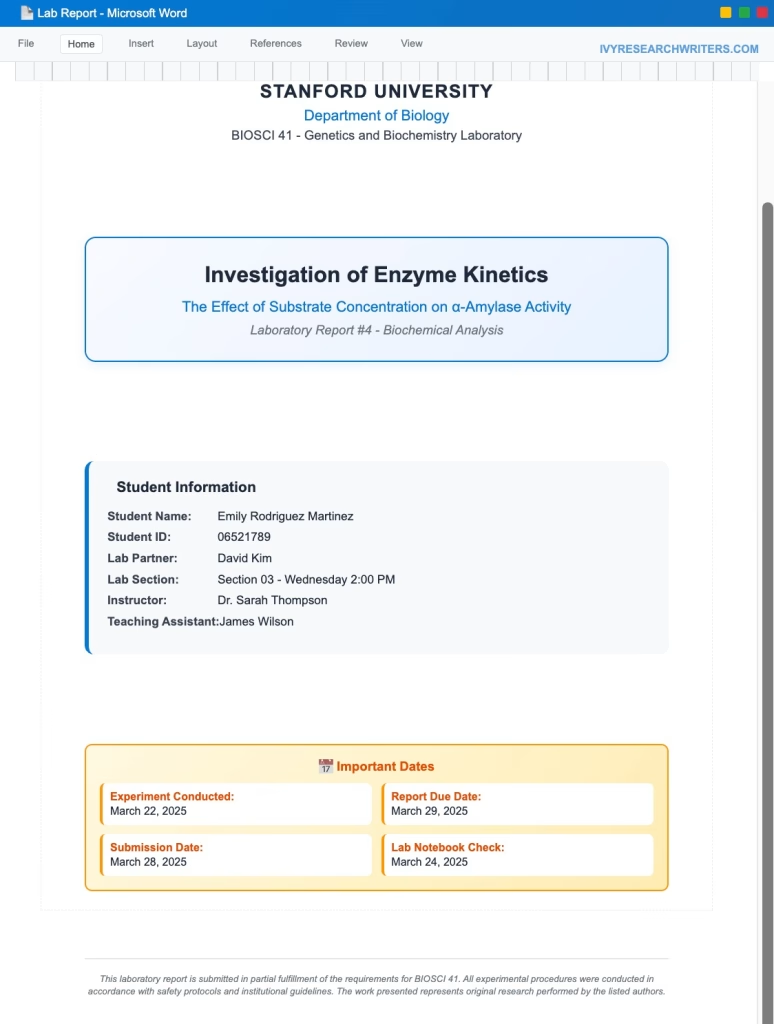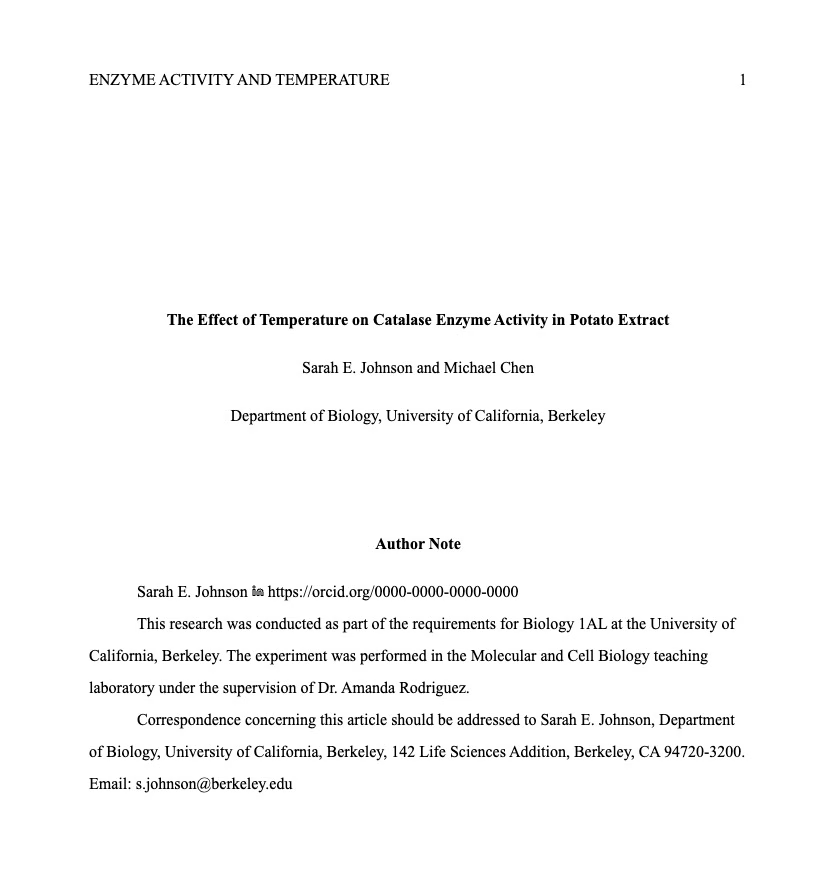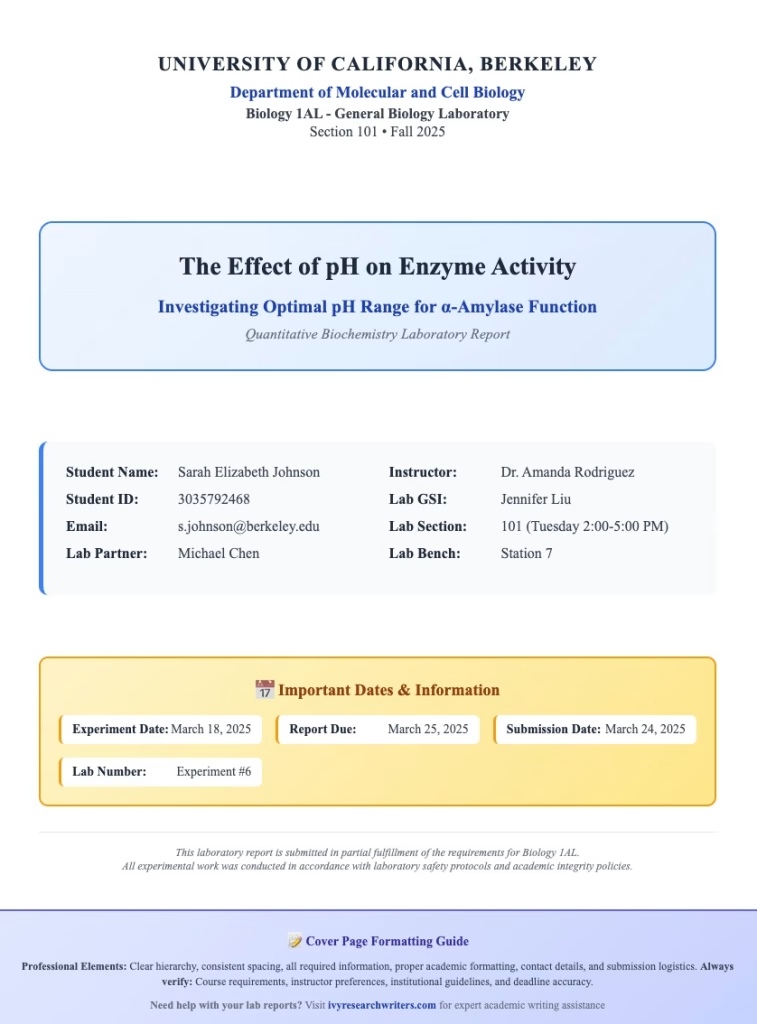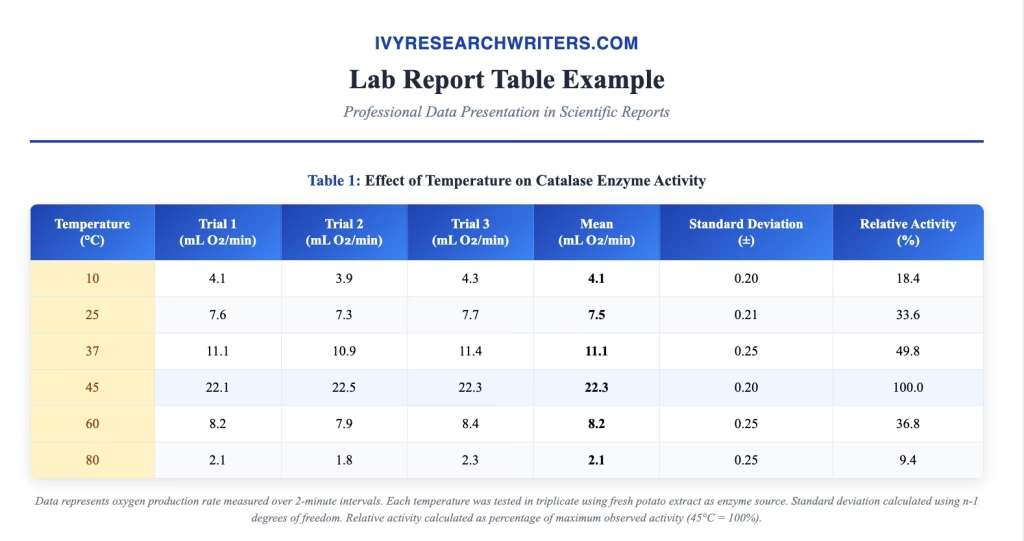Lab Report Title Page: Everything You Need to Know for a Perfect First Impression

The lab report title page is the first impression your work will make, and it is important to present this page professionally and correctly. A well-organized title page not only sets the tone for your entire lab report but also adheres to formatting guidelines, like those in APA format, which is commonly used in scientific writing. In this blog post, we will dive into the essential components of the title page and how to craft it following APA 7th edition formatting rules, focusing on lab report formatting, the abstract, and key sections of a lab report.
What is a Lab Report Title Page?
A lab report title page serves as the first page of your lab report and provides the reader with essential information about your experiment, including the experiment’s title, your name, institution, course name, and date of submission. It should be formatted clearly and professionally to reflect the academic nature of the work. A title page sets the framework for the rest of the report, and it allows the reader to quickly identify the report’s purpose and author.
Key Components of a Lab Report Title Page
The title page contains several essential components that provide clear, organized information about the experiment. These include:
- Title of the Experiment: A concise yet descriptive title of your experiment. Avoid overly long titles and make sure it reflects the key concept of the experiment.
- Author’s Name: Include your full name to identify yourself as the author of the report.
- Institutional Affiliation: This is typically the name of your college or university.
- Course Name: The course for which the lab was conducted.
- Instructor’s Name: The professor or instructor overseeing the lab.
- Date of Submission: The exact date on which you submit the report.
APA Title Page Format: Understanding the Structure
If you’re following the APA format, which is widely used in the sciences, the APA 7th edition title page includes several specific formatting rules. This format is required for clarity, uniformity, and professionalism.
- Font: Use Times New Roman, size 12, and double-spacing throughout the page.
- Title: The title of the experiment should be centered on the page, in bold font. It should be placed a few lines below the top of the page.
- Author’s Name: Place your full name directly under the title, centered.
- Institution: After your name, include your institution (e.g., the university where the lab is being conducted), centered.
- Course Information: Below the institution name, include the course number and name.
- Instructor’s Name: Below the course name, include the name of your instructor.
- Date: Finally, the submission date should appear at the bottom, centered on the page.
Here is an example of how the APA format for the first page may look for a chemistry lab report:

This layout follows APA guidelines for the first page and should always be used unless specified otherwise by your instructor.
How to Make a Cover Page for a Lab Report
Making a cover page for a lab report follows a specific structure. Whether you are preparing a research paper cover page or an experiment-based lab report, it’s crucial to ensure that the cover page looks clean and organized.
- Title of the Experiment: This should be the first element of your title page. Ensure it’s clear and descriptive of your experiment.
- Your Name: Directly under the title, write your name in full, without initials or abbreviations.
- Institutional Information: Include the name of your university or college.
- Course Name and Number: Include the name of the course and its number.
- Instructor Name: Include your instructor’s name beneath the course information.
- Date: The last element should be the date you are submitting the report.
Example Cover Page for a Lab Report:

Writing the Lab Report Abstract
The abstract of a lab report provides a brief summary of the experiment. It typically includes the purpose, methods, results, and conclusion. The goal of the abstract is to provide the reader with an overall understanding of the experiment without needing to read the entire report.
Lab Report Abstract Example
Here’s an abstract for a lab report example:
“This experiment examined the effect of varying light intensities on the rate of photosynthesis in Elodea plants. The hypothesis was that an increase in light intensity would result in a higher rate of photosynthesis. A graphical analysis of the data showed a clear correlation between increased light intensity and oxygen production, indicating that light intensity does influence the photosynthetic rate. Further studies could investigate other environmental factors affecting photosynthesis.”
This lab report abstract example is concise and highlights key points such as hypothesis, methods, results, and conclusions.
What is a Cover Page for a Lab Report?
The cover page for a lab report, also called the title page, is the first page of the report. It contains essential information such as the title of the experiment, the author’s name, and the institution. The purpose of the cover page is to clearly identify the experiment and its author while adhering to academic standards like the APA format.
Here’s a lab report title page for Experiment 17 that you can easily use to start writing your lab report in APA format:
Formatting a Table for a Lab Report
In a lab report, you may need to include a table to present data. A well-organized table is crucial for clear data presentation. Here are the steps to follow for proper table formatting:
- Table Number: Place the table number in the top left corner of the table (e.g., “Table 1”).
- Table Title: Write a clear and concise title for the table. The title should describe what the table is showing.
- Column Headings: Label each column with descriptive headings. For example, “Temperature (°C)” and “Rate of Photosynthesis (ml/min)”.
- Data: Enter your numerical data clearly and consistently.
Example of a Table in a Lab Report:

This table organizes the experimental results in a clear and easy-to-read format.
Creating a Lab Report Title Page: A Step-by-Step Guide
The title page is the first and most important part of your lab report as it provides the first impression of your work. Crafting a well-organized and properly formatted title page is critical for any scientific report. Whether you are writing a chemistry lab report format or a physics lab report, the title page needs to adhere to specific guidelines.
How to Do a Cover Page for a Lab Report?
When you write a lab report, you need to create a cover page or title page that includes several key pieces of information. This page gives the reader a clear overview of the experiment, its purpose, and the relevant details about the researcher and their academic context.
To properly do a cover page for a lab report, follow these steps:
- Title of the Experiment: This should be the main element of your cover page. The title should be concise and directly describe the experiment or investigation you conducted. For instance, “The Effect of Light on Photosynthesis in Elodea Plants.”
- Your Name: This identifies the author of the report.
- Institution Name: Thename of your university or college (e.g., University of Ivy).
- Course Name and Number: This section identifies the subject of the course in which the lab report was written (e.g., Biology 101).
- Instructor’s Name: Include the name of the instructor overseeing the lab.
- Date: The date when the report is due or submitted.
How to Make a Cover Page for a Research Report?
A cover page for a research report is structured similarly to a lab report title page. However, in research reports, you often need to include a more specific abstract or summary of the research. Here’s how to format the cover page for your research report:
- Title: Make it descriptive but brief.
- Author Information: Your full name and affiliation (institution).
- Course Information: The course name, instructor’s name, and date.
If you’re following APA format for the first page, the font should be 12 pt Times New Roman, and the text should be double-spaced. The title should be centered on the page, followed by your name and the institution.
What is a Cover Page for an Essay?
A cover page for an essay is essentially the title page of the essay. It follows the same format as a lab report cover page but is more straightforward. It typically includes:
- Title of the Essay: The title should be centered, describing the essay’s main topic or thesis.
- Author’s Name: Your full name.
- Institution: The name of your school or university.
- Course Name: The specific course or subject.
- Instructor’s Name: The name of the professor or instructor.
- Date: The submission date of the essay.
What is a Cover Page in a Report?
A cover page in a report serves the same function as in a lab report or research paper. It provides the reader with a quick reference to the title, author, institution, course, and date of the report. The cover page helps organize your work and ensures it meets the necessary formatting standards, whether you’re working on a lab report or research paper.
What Should Be on the Title Page of a Lab Report?
The title page of a lab report includes several important pieces of information that should be placed in a clear and organized manner. Here’s what should appear on the title page:
- Title of the Experiment: The main title should accurately reflect the content of the report.
- Your Name: This identifies the author of the lab report.
- Institutional Affiliation: The name of your college or university.
- Course Name and Number: Identify the course in which the lab report is being written.
- Instructor’s Name: This identifies the instructor overseeing the experiment.
- Date: The date the report is due or submitted.
When writing a lab report, make sure to follow the formatting guidelines, especially APA format for the first page. This includes page numbers, proper spacing, and alignment of text.
Lab Report Abstract: A Critical Component
The abstract in a lab report provides a brief summary of the experiment, including the methods used, results, and conclusion. It gives readers a concise overview of the entire report. A well-written abstract for lab report example should be precise, clear, and no longer than 150–250 words. Here’s an example:
Abstract for lab report example:
“This experiment aimed to examine the effect of temperature on the rate of enzyme activity. The results indicated a positive correlation between temperature and reaction rate, with the optimal temperature being 37°C. These findings confirm that temperature affects enzyme catalysis, supporting the hypothesis that enzyme activity increases with temperature up to a certain point.”
Writing Lab Reports: Key Sections
When you write a lab report, ensure that all sections are present and properly formatted. These sections typically include:
- Introduction: This section outlines the background information, hypothesis, and purpose of the experiment.
- Methods/Procedure: Describe the step-by-step process you followed during the experiment. Ensure this section is detailed enough for others to replicate the experiment.
- Results: Present the data you collected in numerical or graphical form. Use figures and tables to support your findings.
- Discussion: Analyze your results, compare them with your hypothesis, and discuss any errors, bias, or factors that could have influenced the outcome.
- Conclusion: Summarize the findings and suggest possible future experiments or improvements to the method.
- References: Cite any sources used throughout the experiment, ensuring proper citation formatting.
How to Write a Lab Report: Tips for Success
When writing your lab report, keep these things in mind:
- Be concise but detailed in your writing.
- Avoid using personal pronouns and instead write in the passive voice.
- Use graphs, tables, and figures to present data clearly.
- Ensure that your report writing follows the experiment outline and includes each section in the proper order.
Writing Lab Reports: Avoiding Plagiarism
When writing a lab report, always ensure that you are following the guidelines for proper citation to avoid plagiarism. All sources of information, whether data, procedure descriptions, or ideas, should be properly referenced using APA or your instructor’s preferred citation style. A well-researched and properly cited lab report ensures that you maintain academic integrity.
This extensive guide on writing a lab report title page, abstract, and other key sections provides the structure and formatting tips needed to produce a professional and well-organized report. By adhering to these principles and APA format, you can ensure that your lab report stands out for its clarity, accuracy, and professionalism. If you need help with writing lab reports or lab report formatting, IvyResearchWriters.com is here to assist you! Reach out to us for expert support!
How to Conclude a Lab Report
Need a Top-Notch Lab Report?
Struggling with your lab report? Let IvyResearchWriters.com do the heavy lifting for you!
Get high-quality, custom-written reports tailored to your requirements.
Order now and experience excellence with every page.
The conclusion of your lab report should summarize the main findings of the experiment. You should discuss whether your hypothesis was supported by the data and address any unexpected results or errors in the experiment. The conclusion should also suggest future experiments or improvements that could be made.
To conclude effectively, use these steps:
- Restate the hypothesis and whether it was supported.
- Summarize the results in relation to the hypothesis.
- Discuss any experimental errors or limitations.
- Suggest any improvements or future experiments.
Conclusion
The lab report title page is a critical part of any scientific report, as it provides the reader with essential information and sets the tone for the rest of the report. By following APA guidelines and understanding the key components of the title page, abstract, and other sections like the methods, results, and discussion, you can ensure your report is professional, well-organized, and easy to read. Always check with your instructor for any specific guidelines or additional requirements for formatting your lab report or title page.
Whether you’re working on a chemistry lab report or writing a biology report, these formatting tips will guide you in presenting your research in the best possible light. IvyResearchWriters.com offers expert writing assistance for lab reports, research papers, and essays, ensuring that your work meets the highest academic standards. Contact us today for professional writing support!
FAQs: Lab Report Title Page Format: Lab Report Cover Page Guide
How to Write a Title Page for a Lab Report?
When writing a title page for a lab report, it is important to follow the proper formatting guidelines and include the key elements required. For instance, in the APA format for the first page, the title page should contain:
- Title of the Experiment: The title should be clear, concise, and directly related to the experiment you conducted. Avoid overly complex or lengthy titles.
- Your Name: Include your full name under the title.
- Institution Name: The name of your college or university.
- Course Name: The specific course for which the report is being written (e.g., Physics 101).
- Instructor’s Name: Include the name of the instructor or professor overseeing the lab.
- Date: The date you are submitting the report.
The title page is the first part of the lab report sample, so ensure it is organized and professional. The APA paper cover page also includes page numbers, which should be placed in the top right corner of the page.
How to Do a Title Page for a Report?
To create a title page for a report, the process is similar to writing a title page for a lab report. The cover page should be formatted according to the specific style guide you’re following (e.g., APA). The main components of the title page for any research report should include:
- Title of the Report: This should be straightforward, describing the research or experiment you conducted.
- Your Name: Place your name under the title, centered.
- Institution/College Name: Your institution’s name (e.g., University of Ivy).
- Course Name and Instructor’s Name: Include the course number and instructor’s name.
- Date: The date of submission should also be included at the bottom.
For instance, if you’re working on a chemistry lab report format, you would follow these guidelines for clarity and professional presentation.
Does a Lab Report Need a Title?
Yes, a lab report needs a title. The title of your report is one of the most essential elements as it immediately informs the reader about the experiment. A title provides context for the content, and a precise title helps to capture the essence of the experiment in a few words. For example, in a lab report sample on photosynthesis, your title might be something like “The Effect of Light Intensity on Photosynthetic Rate.”
The title should be placed on the title page, following the APA format for the first page, and should be clearly visible. The title must be concise yet descriptive enough to convey the topic of the experiment.
What Should Be on Your Title Page?
The title page of your lab report should include several key components:
- Title of the Experiment: The main title should be placed near the top of the page and must be descriptive yet concise.
- Your Name: Place your full name just below the title.
- Institution Name: The name of the college or university where you are studying.
- Course Name: Include the course name you are completing the report for (e.g., Chemistry 101).
- Instructor’s Name: The name of your instructor or professor.
- Date: The date when the report is being submitted.
Additionally, make sure to format your title page according to the APA paper cover page guidelines. In some cases, your title page might also include a brief abstract or a summary of the report if required by your instructor.
The title page must also have page numbers placed in the top right corner and follow the appropriate writing lab report structure and formatting requirements, such as spacing, font size, and alignment.
When formatting, check that all elements are properly aligned, and if necessary, refer to any guidelines provided by your instructor. Also, make sure that citation and references are correctly formatted, if applicable, following proper citation techniques.
By adhering to these guidelines, you’ll ensure that your lab report title page is professional, well-organized, and ready for submission.

